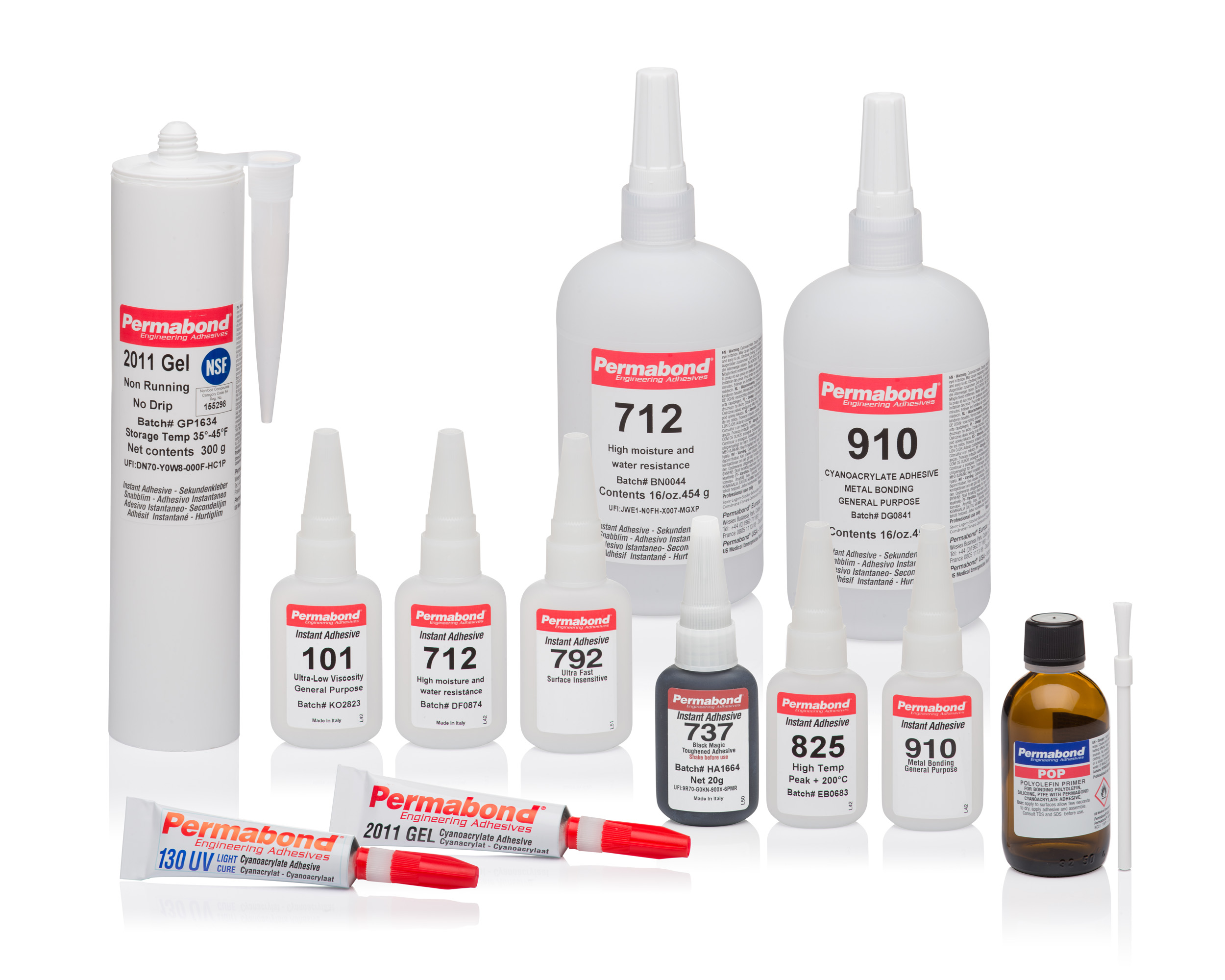
Permabond still manufactures the original cyanoacrylate formulation Permabond 910 (previously Eastman 910). The name 910 comes from counting to 10, as the inventor determined that the product sets in between 9 and 10 seconds.
Since that original methyl cyanoacrylate formulation, Permabond has expanded the versatility of its cyanoacrylate product line to include a tremendous number of formulations, each with unique characteristics that overcome specific design and manufacturing challenges. These include more methyl cyanoacrylates as well as ethyl cyanoacrylates and alkoxy alkyl cyanoacrylates.
Permabond cyanoacrylates are ideal for bonding materials such as metal, rubber, composite, plastic, silicone, and many other substrates. New formulations continue to eliminate design challenges encountered by engineers trying to bond difficult plastics such as polypropylene, polyethylene, PTFE, and other polyolefins. Permabond’s high-performance industrial cyanoacrylate adhesives provide very fast set times, a range of viscosity choices as well as non-blooming / low odor formulations, and products with very high-temperature resistance.
Simply put, cyanoacrylate is an acrylic monomer that cures into a ‘plastic.’
Permabond’s cyanoacrylate adhesives (also called instant adhesives or super glue) cure (harden) by reacting to very small amounts of moisture present on the surface of the substrates. That’s it – no ovens, no mixing, no specialty curing equipment – they simply cure from the residual moisture naturally occurring on the surface of the components. Permabond recognizes that in applications such as wire tacking and tamper-proofing the adhesive is not compressed between two surfaces. For this type of application where the adhesive is exposed, activators are available. Simply spray the activator on the exposed cyanoacrylate to instantly cure it. Cyanoacrylate activators can also be used on very dry or acidic parts, or to facilitate a cure prior to wicking into porous substrates.
Whether you are using cyanoacrylates for bonding, sealing, tamper-proofing, wire tacking, or simply as a manufacturing aid while you wait for another adhesive to set, Permabond has the solution to meet your needs. Highlights of a few products follow:
Permabond products 919, 920, and 922 withstand up to 250°C (482°F) after a secondary heat cure. Permabond 825 uses patented technology and offers the highest temperature resistance of all our cyanoacrylates. The technology will withstand 200°C (390°F) without a secondary heat cure.
Permabond has many very high viscosity cyanoacrylates and offers a true thixotropic gel adhesive. The thixotropic gel is ideal for applications where you want the adhesive to stay in place even on vertical surfaces. The gel is also surface insensitive, so it bonds to a wide variety of substrates, including acidic substrates.
Blooming is the name for a fine white residue that surrounds the bond area. This can happen due to a reaction between the cyanoacrylate and moisture present on the substrate surface. Permabond’s 940 series is non-blooming and virtually odor-free. Permabond’s chemists perfected the low odor technology of this series so that the adhesives are fast curing and provide high bond strength to a variety of surfaces.
By nature, cyanoacrylates are not incredibly impact resistant. Permabond’s toughened grade cyanoacrylates 731, 735 and 737 have been designed to provide fantastic impact and peel resistance for this class of adhesive. They were initially designed for flexible substrates, but the added flexibility and toughness of these products provide even greater shear strength on rigid materials like steel. Permabond 735 and 737 are opaque black and Permabond 731 is crystal clear.
Permabond 2011 gel is listed on the NSF non-food compounds registry. Permabond 2011 is a non-sag, non-drip, thixotropic gel that forms strong bonds to metal, plastics, elastomers, ceramics, and wood. This product has excellent gap-fill capability, {(0.50mm) 0.020 in} and develops strength rapidly. Handling time can be achieved in less than 10 seconds. Once fully cured the bonds are high temperature resistant {(-55 to +120°C) -65 to +250°F} and have good resistance to non-polar solvents. In addition to Permabond 2011 registered as NSF S4, Permabond has several products listed to NSF/ANSI 61 for potable water as well as epoxies that comply with the FDA Food Grade Codes CFR 175.105 and 175.300.
101 – Wicking type, plastic bonding
2010 – Thixotropic, maximum gap fill
240 – Good flow control, plastic bonding
268 – Fast curing, good gap fill
731 – Excellent peel, shear, and impact strength – clear
737 – Excellent peel, shear, and impact strength – black
791 – Surface insensitive, very fast set
792 – Surface insensitive, very fast set, higher temperature resistance
910 – The original – general purpose, metal bonding
919 – Resists 250 C after post cure – wicking type
920 – Resists 250 C after post cure
922 – Resists 250 C after post cure – max gap fill
940 – Low odor & non-blooming, wicking type
943 – Low odor & non-blooming, general purpose